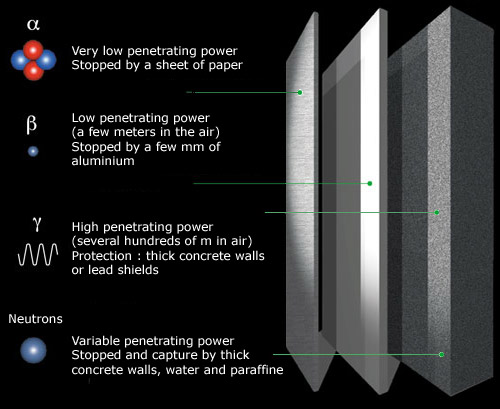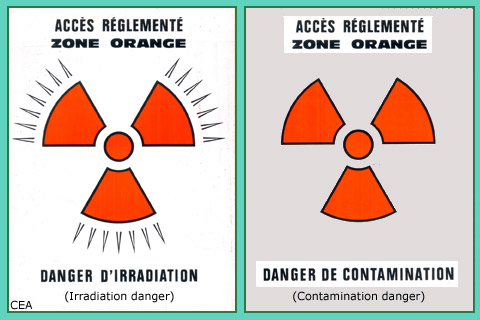The art of protection against radiation hazards
The purpose of radioprotection is to minimize the risk radioactivity poses to human beings. This is done by reducing potential exposure wherever possible: problematic, of course, when it comes to natural exposure and radiation specifically used in medical examinations.

Protective screens:
The four types of radiations have very different penetrative abilities. Alpha and beta radiation can be stopped by a few mm of aluminium – but they have a high ionising power over their short path through matter. Gamma rays, on the contrary, do not ionize until they interact with an atom électron or nucleus. The relative matter transparency with respect to gamma is widely used in radiodiagnostics but make them difficult to absorb in radioprotection. The flux of neutrons are intense near the core of nuclear reactors. There are effective techniques to slow them down and capture them.
IN2P3
Before any sort of protection can be put in place, the risks involved have to be properly understood. When it comes to radioactivity or ionising rays, the three things that have to be carefully monitored are the activity of the source (in becquerels), the amount of energy absorbed (in grays) in the body, and above all the biological dose (in millisieverts). A good understanding of the relationship between an absorbed dose and its potential effects is essential for any attempt to remain safe.
The basic questions of radioprotection follow on from common sense: how penetrative are the different types of radiation, and how can we stop them from reaching us? Over the years, a wide variety of techniques have been developed, with varying degrees of success.
The risk posed by sources external to the body can be reduced by placing a screen in the path of the oncoming radiation. While alpha and beta rays can be stopped by comparatively thin layers of material, gamma rays are much harder to absorb.

Irradiation and contamination:
The two main hazards in radioprotection are those due to irradiation and contamination. Irradiation is caused by X-rays or gamma rays emitted by an external source, against which one can interpose protective screens. Contamination, on the other hand, is the danger posed by the contact, the inhalation or the ingestion or radioactive substances. In that case, the damage come mainly from alpha and beta particles.
© CEA
When it comes to exposure from a source within the human body, there is very little that can be done, besides flushing it out whenever possible. The warning to stay away from radioactive substances, as obvious as it seems, is the only way to avoid the potentially fatal ingestion of radiation sources.The body responsible for setting the relevant safety standards is the International Commission on Radiological Protection (ICRP), an advisory body founded in 1928. An important part of its job is defining the maximum dose individuals should be exposed to; both naturally as well as during medical examinations.
These minimum doses are usually defined for the ‘average’ person, with individual specifications often going much higher or lower. Those people whose jobs revolve around the handling of radioactive substances, for instance, have a higher limit on the amount of radiation they can absorb.
International bodies that establish standards for radioprotection are gradually setting more and more cautious limits. The current ‘maximum dose’ permissible for the general public is around 40% of the natural exposure levels to radiations, which are quite low.
Articles on the subject « Radioprotection »
Radioprotection principles
Applying common sense rules according to radiation nature The need for protection from radiation [...]
Gamma Radioprotection
A penetrative radiation more difficult to absorb In the case of ingestion of radioactive substanc[...]
Gamma Attenuation
Attenuation of a gamma beam Of the three types of radiations, gamma rays are the most penetrative[...]
Gamma Absorption
Heavy materials for the absorption of gamma rays In terms of radioprotection mitigate gamma rays [...]
Radioprotection neutrons
A rare radiation, dangerous, penetrating, difficult to absorb The neutron radiation is more penet[...]
Radioactive Decontamination
Avoid all contact, ingestion and inhalation One of the tasks of radiation protection is the decon[...]
Justification and optimisation
In medicine, use of radiation must be justified The ‘Justification and Optimization » princ[...]
Reglementations and controls
Strict regulations for an efficient radioprotection Radioprotection has a long history. Its princ[...]
Dose legal limits
Applying the precautionary principle and setting cautious limits French regulations set at 1 mSv [...]
Actors in radioprotection
The actors and the basics of radioprotection regulations The rules of radiation protection are no[...]